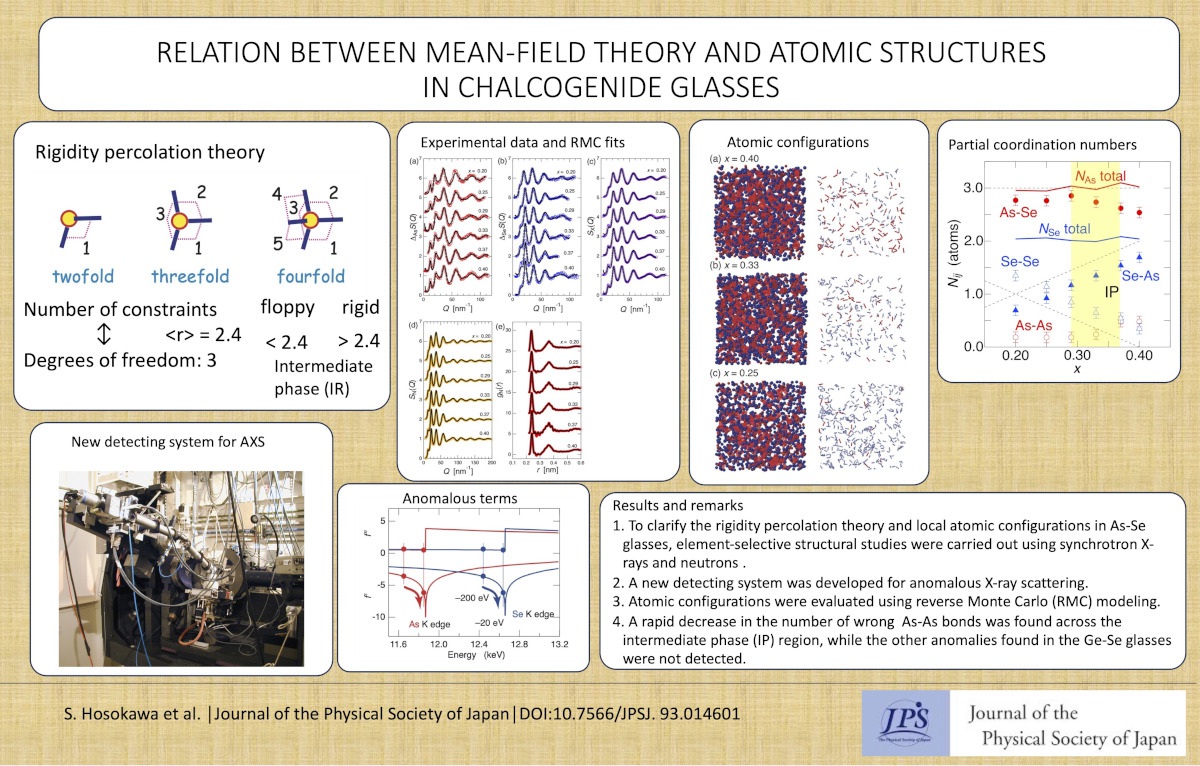Relation between Mean-Field Theory and Atomic Structures in Chalcogenide Glasses
© The Physical Society of Japan
This article is on
J. Phys. Soc. Jpn.
93,
014601
(2024)
.
The authors conducted various of X-ray and neutron scattering experiments on typical chalcogenide glasses and clarified the relationship between the atomic structure and simple rigidity percolation theory.

Rigidity percolation (mean-field) theory is a simple theory that can explain several anomalies in the thermodynamic properties of covalently bonded glasses such as chalcogenides. According to this theory, the atoms in covalent glasses are constrained by either bonds or bond angles. When the constituent atom has coordination number r, the bond constraint and bond angle constraint are r/2 and 2r-3 per atom, respectively. If the averaged sum of these constraints is equal to the degree of freedom of three in three dimensions, i.e., r = 2.4 at x = 0.40 for AsxSe1-x glasses and x = 0.20 for GexSe1-x glasses, the glasses show excellent glass forming ability separated between rigid (r > 2.4) and floppy (r < 2.4) glasses. Further, calorimetric and Raman scattering experiments revealed that the transition occurred within a certain composition range of the intermediate phase (IP) of the unstressed rigid phase.
This article presents a series of structural studies using element-selective diffraction techniques with synchrotron X-rays and high-flux neutron sources to investigate the structural changes across the IP transition phase in chalcogenide glasses. Technical improvements were achieved by developing a new detection system with a curved graphite analyzer crystal and a 1-m-long detector arm at the beamline BM02 of the European Synchrotron Radiation Facility (ESRF). Experimental X-ray and neutron diffraction data and anomalous X-ray scattering (AXS) results close to the absorption edges of the constituent elements were analyzed using reverse Monte Carlo modeling to reveal changes in intermediate-range atomic configurations across the IP range from rigid to floppy. The AsxSe1-xglasses have an IP range of x = 0.29-0.37, where a rapid decrease in the number of wrong As-As bonds is observed. However, other anomalies found in Ge-Se glasses were not clearly observed, such as a rapid decrease in the pre-shoulder positions in the Se-Se partial structure factor, SSeSe(Q), a rapid decrease in the number of edge-sharing connections, and an exclusion tendency of the connections between the As (Ge) atoms sharing two Se atoms. These differences may be related to the anisotropic pyramidal AsSe3 units in the As-Se glasses, in contrast to the isotropic tetrahedral GeSe4 units around the Ge atoms in the Ge-Se glasses. This study was supported by a JSPS Grant-in-Aid for Transformative Research Areas (A) Hyper-Ordered Structures Science.
(Written by S. Hosokawa on behalf of all the authors.)
J. Phys. Soc. Jpn.
93,
014601
(2024)
.
Share this topic
Fields
Related Articles
-
Qualitative Changes in Kinetic Pathways Driven by Hydrodynamic Interactions in Dense Colloidal Suspensions
Cross-disciplinary physics and related areas of science and technology
Statistical physics and thermodynamics
Structure and mechanical and thermal properties in condensed matter
2025-4-18
Even in dense colloidal suspensions, where long-range hydrodynamic interactions are screened, near-field hydrodynamic interactions qualitatively influence the selection of kinetic pathways.
-
Bayesian Insights into X-ray Laue Oscillations: Quantitative Surface Roughness and Noise Modeling
Measurement, instrumentation, and techniques
Structure and mechanical and thermal properties in condensed matter
2025-2-14
This study adopts Bayesian inference using the replica exchange Monte Carlo method to accurately estimate thin-film properties from X-ray Laue oscillation data, enabling quantitative analysis and appropriate noise modeling.
-
Hyperuniform and Multifractal States in Bosonic Quasicrystalline Systems
Statistical physics and thermodynamics
Structure and mechanical and thermal properties in condensed matter
2025-2-10
Quantum states can be categorized as hyperuniform or multifractal based on electronic characteristics. This study demonstrates that bosonic quasicrystalline systems exhibit hyperuniform or multifractal quantum states.
-
Spin-Spin Interaction Mediated by Rotational Lattice Vibrations
Magnetic properties in condensed matter
Structure and mechanical and thermal properties in condensed matter
2025-1-24
This study predicts the presence of spin-spin interactions mediated by the angular momentum of lattice vibrations, which can be long-range.
-
Unlocking Secrets of Novel Charge-Orbital States in Transition-Metal Compounds
Cross-disciplinary physics and related areas of science and technology
Electron states in condensed matter
Electronic structure and electrical properties of surfaces and nanostructures
Magnetic properties in condensed matter
Structure and mechanical and thermal properties in condensed matter
2025-1-6
A new Special Topics edition of the Journal of the Physical Society of Japan features articles exploring special transition-metal compounds that exhibit novel charge-orbital states.




